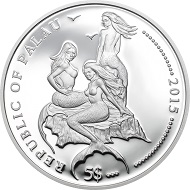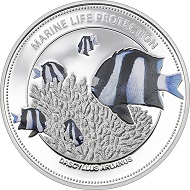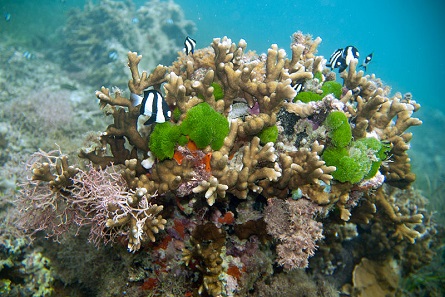March 17, 2016 – The White Tail Damselfish (Dascyllus aruanus) graces the recent creation of Coin Invest Trust on behalf of the Pacific island state Palau. Available in three versions, the coin presents the latest addition to the popular “Marine Life Protection” series.
Palau / 5 Dollars / Silver. 925 / 25 g / 38.61 mm / Mintage: 1500.
The obverse features three mermaids on a rock as well as the name of the issuing state, the nominal value, and the year of issue.
Continuing the style of the series, the reverse of the gold coin depicts one White Tail Damselfish, the other two issues each five fish in colour against a stylised coral. Engraved above are the name of the series, MARINE LIFE PROTECTION, and DASCYLLUS ARUANUS.
White Tail Damselfish. Photograph: Paul Asman and Jill Lenoble / https://creativecommons.org/licenses/by/2.0/deed.en
The distinctly coloured White Tail Damselfish (Dascyllus aruanus) belongs to the family of the Pomacentridae. Its alternative name, banded Dascyllus, is derived from its three broad, black bands, which beautifully contrast with its otherwise white body. The fish is native to the Western Pacific and a large region that stretches all the way from Japan to Sydney, the Line Islands, to the Marquesas Islands and finally the Tuamotu Archipelago.
Lagoons and coastal reefs are the White Tail Damselfish’s preferred habitat, where large groups of it populate the stony corals (Acropora) that branch out over wide areas. When in more open waters, it prefers smaller, single coral stocks. The damselfish feeds on seaweed, small invertebrates and zooplankton. Fans of fishkeeping around the world value this low-maintenance fish species, even though the fish display territorial aggression towards newcomers and during the mating season.
To attract a female for mating, the male performs a kind of “dance” a good meter above the potential nest site. When spawning, the female releases more than 1000 eggs on solid ground. Both parental animals take care of the eggs before the larvae hatch after 3 to 5 days. The juvenile fish live in the pelagic zone until they move to stony coral colonies as adult fish.
The coins were minted by B. H. Mayer’s Kunstprägeanstalt GmbH. Collectors can purchase the issues through specialty dealers.
Further information about Marine Life Protection – White Tail Damselfish is available here, here and here.
This is the website of Coin Invest Trust.
Learn more about the White Tail Damselfish here.
And the White Tail Damselfish’s mating dance can be watched here.







